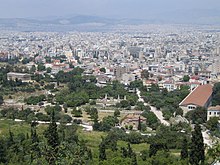History of cities
Ancient cities allowed for the pooling of resources, exchange of ideas, large marketplaces, and even some shared amenities such as drinking water, sewerage, law enforcement, and roads.
[1] Various technologies such as bricks, pottery, and animal taming played a large role in the costs and benefits of maintaining the earliest forms of cities.
The increased food production per unit of land supported higher population density and more city-like activities in areas suitable for agriculture.
", a paper by Harvard economist Edward L. Glaeser, delves into similar reasons for city formation: reduced transport costs for goods, people and ideas.
Discussing the benefits of proximity, Glaeser claims that if a city is doubled in size, workers get a ten percent increase in earnings.
The workers do not benefit much from the ten percent wage increase, because it is recycled back into the higher cost of living in a larger city.
The first true towns are sometimes considered large settlements where the inhabitants were no longer simply farmers of the surrounding area, but began to take on specialized occupations, and where trade, food storage and power were centralized.
The peoples of Southwest Asia and Egypt laid the foundations of Western civilization: they developed cities and struggled with the problems of organised states as they moved from individual communities to larger territorial units and eventually to empires.
Theories that attempt to explain ancient urbanism by a single factor, such as economic benefit, fail to capture the range of variation documented by archaeologists.
[citation needed] Mesopotamia, the area of the Tigris and Euphrates within modern day Iraq and Syria, was home to numerous cities by the third millennium BCE.
[14] Cities such as Jericho, Uruk, Ur, Nineveh, and Babylon, made legendary by the Bible, have been located and excavated, while others such as Damascus and Jerusalem have been continuously populated.
[15] Beginning in the early first millennium, independent city-states in Greece began to flourish, evolving the notion of citizenship, becoming in the process the archetype of the free city, the polis.
[17] These Greek city-states reached great levels of prosperity that resulted in an unprecedented cultural boom, that of classical Greece, expressed in architecture, drama, science, mathematics and philosophy, and nurtured in Athens under a democratic government.
Among the early Old World cities, Mohenjo-daro of the Indus Valley Civilization in present-day Pakistan, existing from about 2600 BCE, was one of the largest, with a population of 50,000 or more and a sophisticated sanitation system.
Symbolic cities were constructed as celestial microcosms, with the central point corresponding to the pole star representing harmony and connection between the earthly and other realms.
In particular, Jenné-Jeno featured settlement mounds arranged according to a horizontal, rather than vertical, power hierarchy, and served as a center of specialized production and exhibited functional interdependence with the surrounding hinterland.
[32] Mesoamerica saw the rise of early urbanism in several cultural regions, including the Preclassic Maya, the Zapotec of Oaxaca, and Teotihuacan in central Mexico.
The locus of wealth in the West shifted to Constantinople and to the ascendant Islamic civilization with its major cities Baghdad,[b] Cairo, and Córdoba.
[38] From the 9th through the end of the 12th century, Constantinople, capital of the Byzantine Empire, was the largest and wealthiest city in Europe, with a population approaching 1 million.
[39] By the thirteenth and fourteenth centuries some cities become powerful states, taking surrounding areas under their control or establishing extensive maritime empires.
These cities, with populations in the tens of thousands, amassed enormous wealth by means of extensive trade in eastern luxury goods such as spices and silk, as well as iron, timber, and slaves.
In the first millennium CE, an urban tradition developed in the Khmer region of Cambodia, where Angkor grew into one of the largest cities (in area) of the world.
[41] The closest rival to Angkor, the Mayan city of Tikal in Guatemala, was between 100 and 150 square kilometres (39 and 58 sq mi) in total size.
[42] Although its population remains a topic of research and debate, newly identified agricultural systems in the Angkor area may have supported up to one million people.
[43] While the city-states, or poleis, of the Mediterranean and Baltic Sea languished from the 16th century, Western Europe's larger capitals grew again as commercial hubs, especially following the emergence of an Atlantic trade.
[45] In the United States from 1860 to 1910, the introduction of railroads reduced transportation costs, and large manufacturing centers began to emerge, fueling migration from rural to city areas.
At the end of the 19th century, electric urban rail transport (including trams and rapid transit) began to replace them, later completed with buses and other motor vehicles.
Growth of cities continued through the twentieth century and increased dramatically in the Third World (including India, China, and Africa), due to industrialization, active promotion of urbanization, and other factors.
In the second half of the twentieth century, deindustrialization (or "economic restructuring") in the West led to poverty, homelessness, and urban decay in formerly prosperous cities.
[48] Under the Great Leap Forward and subsequent five-year plans continuing today, the People's Republic of China has undergone concomitant urbanization and industrialization to become the world's leading manufacturer.














